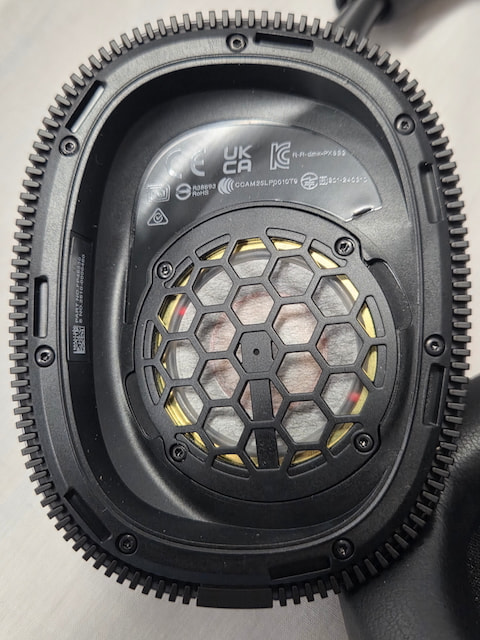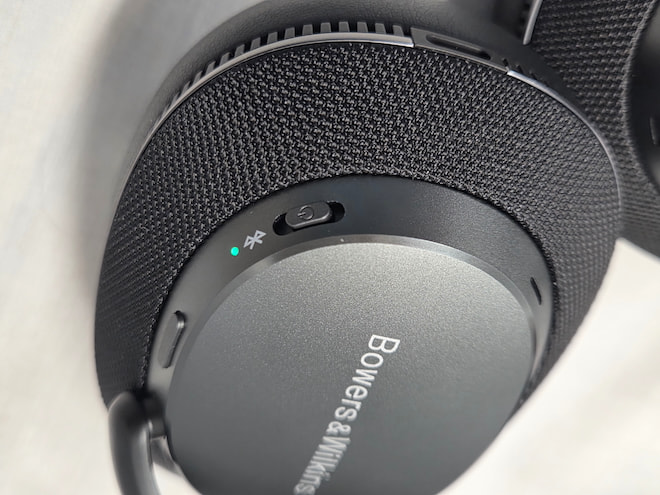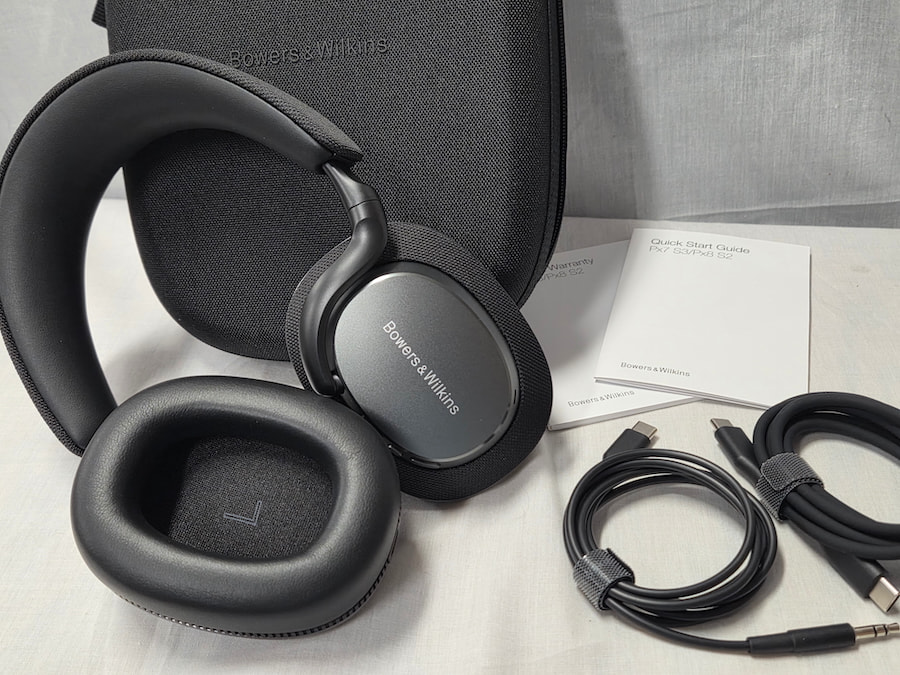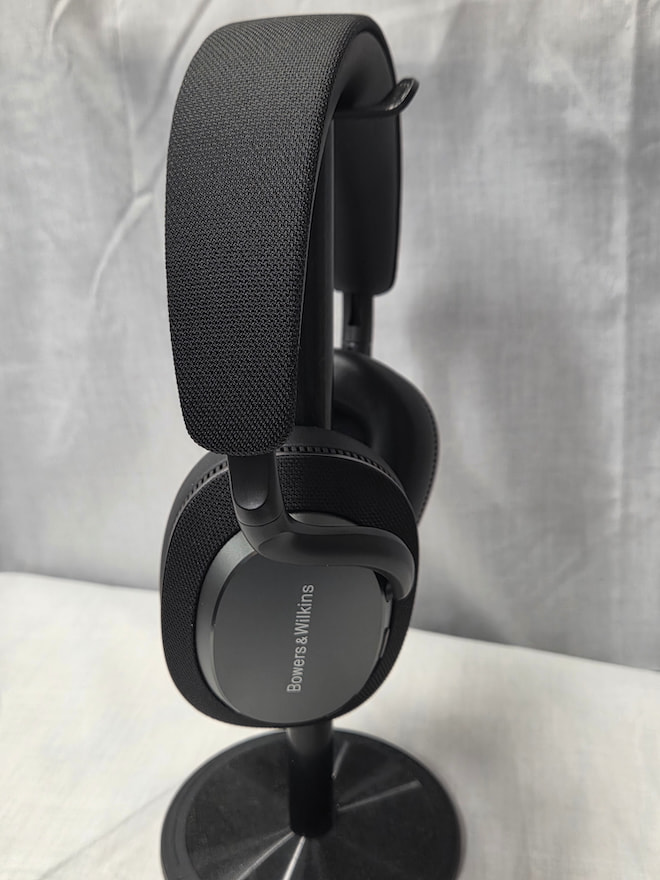Today I’m digging into the Bowers & Wilkins Px7 S3, the fourth generation in the Px7 lineup. Slotted below the Px8 flagship, the Px7 has always been the “mid-tier” option in B&W’s range, though mid-tier here still puts it nose-to-nose with heavy hitters like Sony’s WH-1000XM6 and Sennheiser’s Momentum 4. Since about 2021, both the Px7 and Px8 have been fixtures on our best-of lists, which means expectations for the S3 aren’t just high—they’re set at “don’t screw this up.” Anything less than raising the bar in its class would feel like a stumble, because the Px7 has been the bar since day one.
The S3 traces its DNA back not just through previous Px7s, but all the way to B&W’s P5 headphones from 2009. I owned that first-gen P5—an on-ear that looked the part but wasn’t nearly as refined as what came after. What’s stayed true through all the iterations, though, is Bowers & Wilkins’ knack for premium build and genuine value, even if the tech has evolved a lot since those leather-clad P5 days.
Build Quality & Comfort Fit

The Px7 S3 borrows its overall build language from the pricier Px8, but its $449 retail price plants it squarely between the plastic-heavy flagships from Sony, Sennheiser, and Bose, and the boutique luxury options like the Focal Bathys, B&W’s own Px8, and the Noble Fokus Apollo. At this price point, expectations are higher than “mostly plastic with a fancy logo,” and thankfully the Px7 S3 leans on cloth, leather, and metal in all the right places to feel like it earns its keep.
Color options stay relatively safe but with a twist: black, white, and Indigo. The white and Indigo are unique to the S3, while the anthracite black is the carryover option B&W can’t seem to quit. Each comes with a color-matched hard case—good news if you care about style continuity, bad news if you were hoping for something pocketable. The case is wide enough to make room for the headphones lying flat, but since the Px7 S3 doesn’t fold at the gimbals like the Bose QC45, it eats up more bag space than it should. Inside you’ll find the essentials: the headphones themselves, a USB-C charging cable, and a USB-C to 3.5mm aux cable—because yes, B&W still believes you might want to plug in.
Line up the Px7 S3, Px7 S2, and Px8 in black and you’ll need either sharp eyes or pairing mode to tell them apart—subtle evolution is the name of the game here. The headband keeps its cloth top surface with padded leather underneath, matched to the ear pads for that familiar B&W premium touch. The cups still sport the stepped design: cloth on the outer shelf, anodized metal on the center cap. Gimbals remain anchored by a single connection point at the rear-middle of the cups, allowing 180° rotation vertically and about 35° of inward tilt at the top horizontally. Translation: they swivel enough to stay comfortable, but you won’t mistake them for a contortionist.

Adjustment is via a friction headband mechanism, infinitely variable but offering no tactile feedback—so if you like clicky notches, tough luck. Controls are split logically enough: the left cup hosts the quick action button (for ANC modes), an LED indicator, and the sliding power switch. The USB-C port for charging and wired use sits at the bottom of that cup. Over on the right, three buttons handle volume, play/pause, calls, and track navigation depending on tap sequences—functional if not exactly groundbreaking.
Weight drops by 10 grams from the previous model, coming in at 300 grams. On paper, that’s an improvement; on your head, it feels nearly identical to other Px7 or Px8 models. For context, several competitors in this price range flirt with the 250-gram mark, but given the extra metal and leather here, the real surprise is that B&W didn’t end up heavier.
At 300 grams, the Px7 S3 doesn’t cross into “neck workout” territory, and the headband does a respectable job of spreading that weight so it never feels like a burden. The leather pads add a touch of luxury, though they can run a bit warm over long sessions—occupational hazard of leather—but the memory foam keeps them plush enough that comfort isn’t sacrificed.

Clamping force out of the box is on the firm side, which helps ensure a proper seal for ANC but might feel a little aggressive at first. You’ve got two options: let time break them in naturally, or bend the band slightly to get them where you want. I opted for the latter since, as a glasses wearer, the clamp pushed harder on the mastoid bend than I’d prefer. A minor tweak fixed the issue, leaving me with both a secure seal (critical for ANC to actually work) and comfort that held up across extended listening sessions.
Internals & Audio Technology
The Px7 S3 sticks with a 40mm biocellulose dynamic driver—the same paper-based diaphragm material used in previous generations—but don’t mistake it for a copy-paste job. B&W kept the stiffening resin coating but reworked the chassis, voice coil, and magnets. The new chassis angles the driver toward your ear rather than just plopping it in parallel, while the updated coil and magnet system allow for quicker movement and more excursion. Translation: tighter transients, deeper extension, and less of that “big driver lag” you sometimes hear in wireless cans.

Electronics got an overhaul too. Bluetooth 5.3 is on board, along with a new dedicated DSP handling ANC, EQ, and B&W’s 24-bit TrueSound correction mode. Decoding and amplification are offloaded to a separate DAC/amp chip, which supports up to 24-bit/96kHz audio over USB. Wireless quality, of course, is codec-dependent: SBC and AAC are standard, while aptX Adaptive, aptX HD, and the new aptX Lossless are all supported—making this a step up from the Px7 S2e, which topped out at Adaptive. B&W promises Bluetooth LE Audio and LC3 support via firmware later this year… though “later this year” is doing a lot of work, since the feature missed this review window.
Battery life remains steady at around 30 hours. In practice, our testing saw anywhere from 28 to 32 depending on codec, volume, and ANC use. Still, that’s nearly a full work week of juice before you reach for the charger. And if you do run low, a quick 15-minute top-up nets about 25% charge—enough to get you through a long commute or a flight delay without panicking.
Control App & Smart Features
The Px7 S3 is managed through the Bowers & Wilkins Music app, which has fully replaced the older Headphone Control app. If you’re still trying to use that relic with the Px7 series, good luck—it won’t even recognize them. The Music app covers the essentials: ANC mode selection, a five-band EQ with B&W’s TrueSound option, standby and wear sensor settings, and firmware updates.
On the streaming side, it goes a bit further than most headphone apps by integrating directly with services like TIDAL, Qobuz, Deezer, Amazon Music, and even Pandora (yes, apparently people still use Pandora). The EQ is serviceable, though it labels bands as Lo, Mid, and Hi instead of giving actual frequency ranges—helpful if you’re new, frustrating if you know exactly where you want to make an adjustment. And no, there’s still no true parametric EQ. Like most brands, B&W seems to think “good enough” is the goal here, which will either keep you satisfied or keep you grumbling, depending on how picky your ears are.
Active Noise Cancellation Performance

The Px7 S3 packs eight microphones—some pointing outward, some inward—feeding the DSP so it can analyze outside noise and tweak cancellation in real time. Think of it as a tiny army constantly listening and adjusting. As always with ANC, there’s a trade-off: the more noise you try to kill, the more the sound signature suffers. Low droning sounds? No problem. High-pitched or erratic noises? That’s where the Px7 S3, like most headphones, shows its limits.
B&W has nudged ANC performance slightly forward from the previous generation, but let’s be clear: ANC is still secondary to sound quality here. If you’re hunting for the absolute quietest ride on the subway, Sony or Bose will still have the upper hand. That said, B&W does use its DSP for calls too, via something they call ADI Pure Voice. In my testing, it did a solid job of filtering background chatter while keeping voices clear and natural—not bad for a brand that clearly prioritizes musical fidelity over muting every passing bus.
Listening Experience & Sound Quality
Going into the Px7 S3 listening session, the bar was set pretty high—B&W is calling it their most “advanced and capable” headphone yet. My first reaction: “Really? That’s a bold claim while the Px8 is still sitting hundreds of dollars above this one.” My second: if it actually tops the Px8 in any meaningful way at $450, it better be nothing short of remarkable.

Sub-bass is the first surprise. There’s more depth and quantity than in previous Px7 models, rolling off into the low twenties—or even the high teens—where it’s as much felt as it is heard. Mid-bass benefits from this lift too, but with better clarity and detail, while the sub-bass remains more about impact than nuance. Overall, the tuning has shifted from the relatively safe signature of prior Px7s to a clear V-shape: low-end and upper-mid treble are pushed, roughly aligning with a Harman target curve.
The result is a more engaging, dynamic sound than I expected—just don’t mistake it for a neutral reference; this is still very much a listen-for-fun, not-for-measurements presentation.
Mid-bass on the Px7 S3 delivers solid slam when the track calls for it, yet remains tight and controlled when it isn’t the star. The new driver’s speed really shows here—transient response is noticeably sharper than on previous generations, letting the S3 serve both weighty impact and clean precision simultaneously.
Lower-mids sit in the dip of the V-shaped curve, just behind the mid-bass and upper-mids, but calling them recessed would be generous—they still retain clarity, natural timbre, and vocals cut through the mix without strain. Guitars have energy and texture that benefit from the faster transients, while strings gain vibrancy thanks to the upper-mid and lower-treble lift. Female voices are slightly forward of their male counterparts, but the boost is subtle enough to avoid any harshness, sibilance, or nasality—delivering presence without drawing unwanted attention.
The snare has satisfying rattle, and percussion hits are sharp, with cymbals and hi-hats striking a careful balance between dull and overly clicky. The top end of the S3 has noticeably more air and sparkle than previous Px7 generations, giving the headphones a more open sound with a slightly brighter character.
Soundstage is solid, with clear dimensions across all three planes, though don’t expect cathedral-like expansiveness. Instrument placement is straightforward—no overlaps, no holes—and the overall stage gives the impression of an orchestra seated in a mid-sized college hall. It’s proportional and accurate, just not jaw-dropping in scale.
Given B&W’s bold claim that the Px7 S3 is their most “advanced” headphone yet, I had to pit it against the Px8. If the S3 truly lives up to that statement, it’s going to eat into Px8 sales—especially considering that, these days, the Px8 only runs about $100 more than the Px7 S3.
First thing to note: the S3 plays louder than the Px8 at the same source setting, so don’t assume sliding the volume to the same number will yield a fair comparison. Once levels were matched, it became clear the S3 has deeper low end and a touch more sparkle in the top end, while the Px8 retains a slight edge in midrange richness, with less emphasis on extremes. Put simply, the S3 is now either catching up to or even surpassing the Px8 depending on your tonal preference.
My biggest takeaway? B&W isn’t done. If the S3 can threaten the Px8 like this, you know a Px9—or some other surprise—is waiting in the wings. Brands don’t undercut their flagship without a strategy to reclaim the throne.
The Bottom Line

First, the technical side: yes, LC3 support isn’t live yet, but the Px7 S3 handled aptX Lossless without a hitch. If B&W delivers on their promised firmware update this year, it’s a non-issue. Considering LC3 is just beginning to appear on models like the Noble Fokus Apollo, this seems like a reasonable trade-off.
Second, the tuning. Some might argue the S3 leans toward a more commercial signature, a step away from “audiophile purity.” But the reality is the listening landscape has changed. Most buyers today want a sound that’s engaging and fun, not a strictly neutral reference. Let’s be honest—who is mastering the next pop hit on ANC wireless headphones? These cans are designed for music enjoyment in noisy environments, not for studio-critical mixing.
And enjoy it you will. The S3 is lively, dynamic, and pairs exceptionally well with popular genres thanks to the Harman-plus-bass tuning. ANC removes enough distractions to let you focus without being overwhelming—though it won’t outdo Sony or Bose, it’s certainly good enough. Where the Px7 S3 really shines is in sound quality and detail retrieval, along with build quality. Unless ANC is your absolute top priority, these headphones will likely put a bigger smile on your face than most competitors in this price bracket. Expect to pay at least $100 more to find anything that competes sonically.
The Bowers & Wilkins Px7 S3 delivers an engaging, dynamic, and musically satisfying experience with premium build quality and competent ANC. It outperforms most mid-tier competitors in sound and detail, making it one of the best value propositions for serious listeners who care more about sound than absolute noise cancellation.
Pros:
- Excellent detail retrieval and texture, revealing nuances across all genres
- Premium build quality with a solid, well-thought-out accessory kit
- Stronger bass impact and sub-bass depth than previous Px7 generations
- Tuned for modern listening preferences, engaging and lively signature
- Good soundstage and instrument separation, proportional and accurate
- AptX Lossless support with future LC3 upgrade planned
Cons:
- LC3 Bluetooth support not yet available, pending firmware update
- ANC effective but not class-leading compared to Sony or Bose
- Lower-mids slightly recessed due to V-shaped tuning; may benefit from EQ for personal preference
- Slight warmth from leather pads over long listening sessions
